Three-Dimensional Reconstruction of Evaporation-Induced Instabilities Using Volumetric Scanning Particle Image Velocimetry
Abstract
:1. Introduction
2. Experiments and Methods
2.1. Evaporation Experiments
2.2. Scanning PIV System
2.3. Data Processing
2.4. Determination of Out-Of-Plane Components from Planar PIV and the Continuity Equation
3. Results and Discussion
3.1. Comparison of the Generated 3D Velocity Fields
3.2. The 3D Velocity Field of an Evaporating Liquid
4. Conclusions
Author Contributions
Funding
Conflicts of Interest
References
- Pan, X.; Jin, W.; Liu, Y.; Ai, F. Effect of surface tension-driven flow on BaB2O4 crystal growth from high temperature melt-solution. Cryst. Res. Technol. 2008, 43, 152–156. [Google Scholar] [CrossRef]
- Sutter, T.; Kim, N.; Kyu, T.; Golovaty, D. Crystal nucleation and motion in an undercooled binary solution. Curr. Opin. Chem. Eng. 2015, 7, 1–5. [Google Scholar] [CrossRef]
- Savino, R.; di Francescantonio, N.; Fortezza, R.; Abe, Y. Heat pipes with binary mixtures and inverse Marangoni effects for microgravity applications. Acta Astronaut. 2007, 61, 16–26. [Google Scholar] [CrossRef]
- Di Francescantonio, N.; Savino, R.; Abe, Y. New alcohol solutions for heat pipes: Marangoni effect and heat transfer enhancement. Int. J. Heat Mass Transf. 2008, 51, 6199–6207. [Google Scholar] [CrossRef]
- Savino, R.; Paterna, D. Marangoni effect and heat pipe dry-out. Phys. Fluids 2006, 18, 2–6. [Google Scholar] [CrossRef]
- Bhardwaj, R.; Fang, X.; Somasundaran, P.; Attinger, D. Self-assembly of colloidal particles from evaporating droplets: Role of DLVO interactions and proposition of a phase d iagram. Langmuir 2010, 26, 7833–7842. [Google Scholar] [CrossRef] [Green Version]
- Cai, Y.; Zhang, N.B. Marangoni flow-induced self-assembly of hexagonal and stripelike nanoparticle patterns. J. Am. Chem. Soc. 2008, 130, 6076–6077. [Google Scholar] [CrossRef]
- Lu, S.; Fujii, H.; Nogi, K. Marangoni convection and weld shape variations in Ar–O2 and Ar–CO2 shielded GTA welding. Mater. Sci. Eng. A 2004, 380, 290–297. [Google Scholar] [CrossRef]
- Aucott, L.; Dong, H.; Mirihanage, W. Revealing internal flow behaviour in arc welding and additive manufacturing of metals. Nat. Commun. 2018, 9, 5414. [Google Scholar] [CrossRef] [Green Version]
- Ganzevles, F.L.A.; Van Der Geld, C.W.M. Marangoni convection in binary drops in air cooled from below. Int. J. Heat Mass Transf. 1998, 41, 1293–1301. [Google Scholar] [CrossRef]
- Trantum, J.R.; Baglia, M.L.; Eagleton, Z.E.; Mernaugh, R.L.; Haselton, F.R. Biosensor design based on Marangoni flow in an evaporating drop. Lab Chip 2014, 14, 315–324. [Google Scholar] [CrossRef] [PubMed]
- Bénard, H. Les tourbillons cellulaires dans une nappe liquide.-Méthodes optiques d’observation et d’enregistrement. Journal de Physique Théorique et Appliquée 1901, 10, 254–266. [Google Scholar]
- Block, M.J. Surface tension as the cause of Bénard cells and surface deformation in a liquid film. Nature 1956, 178, 650–651. [Google Scholar] [CrossRef]
- Pearson, J.R.A. On convection cells induced by surface tension. J. Fluid Mech. 1958, 4, 489–500. [Google Scholar] [CrossRef]
- Namura, K.; Nakajima, K.; Kimura, K.; Suzuki, M. Photothermally controlled Marangoni flow around a micro bubble. Appl. Phys. Lett. 2015, 106, 043101. [Google Scholar] [CrossRef] [Green Version]
- Chai, A.T.; Zhang, N. Experimental study of MArangoni-Benard convection in a liquid layer induced by evaporation. Exp. Heat Transf. 1998, 11, 187–205. [Google Scholar] [CrossRef]
- Masoud, H.; Felske, J.D. Analytical solution for inviscid flow inside an evaporating sessile drop. Phys. Rev. E 2009, 79, 016301. [Google Scholar] [CrossRef] [Green Version]
- Zheng, L.; Zhang, X.; Gao, Y. Analytical solution for Marangoni convection over a liquid–vapor surface due to an imposed temperature gradient. Math. Comput. Model. 2008, 48, 1787–1795. [Google Scholar] [CrossRef]
- Tam, D.; Von Arnim, V.; McKinley, G.H.; Hosoi, A.E. Marangoni convection in droplets on superhydrophobic surfaces. J. Fluid Mech. 2009, 624, 101–123. [Google Scholar] [CrossRef] [Green Version]
- Schmitt, M.; Stark, H. Marangoni flow at droplet interfaces: Three-dimensional solution and applications. Phys. Fluids 2016, 28, 012106. [Google Scholar] [CrossRef] [Green Version]
- Hu, H.; Larson, R.G. Evaporation of asessile droplet on a substrate. J. Phys. Chem. B 2002, 106, 1334–1344. [Google Scholar] [CrossRef]
- Kazemi, M.A.; Nobes, D.S.; Elliott, J.A.W. Investigation of the phenomena occurring near the liquid–vapor interface during evaporation of water at low pressures. Phys. Rev. Fluids 2018, 3, 124001. [Google Scholar] [CrossRef]
- Kazemi, M.A.; Elliott, J.A.W.; Nobes, D.S. The influence of container geometry and thermal conductivity on evaporation of water at low pressures. Sci. Rep. 2018, 8, 15121. [Google Scholar] [CrossRef] [PubMed] [Green Version]
- Duan, F.; Ward, C.A. Surface-thermal capacity of D2O from measurements made during steady-state evaporation. Phys. Rev. E 2005, 72, 056304. [Google Scholar] [CrossRef] [PubMed]
- Ward, C.A.; Duan, F. Turbulent transition of thermocapillary flow induced by water evaporation. Phys. Rev. E 2004, 69, 056308. [Google Scholar] [CrossRef] [PubMed]
- Ghasemi, H.; Ward, C.A. Energy transport by thermocapillary convection during sessile-water-droplet evaporation. Phys. Rev. Lett. 2010, 105, 136102. [Google Scholar] [CrossRef] [PubMed]
- Thompson, I.; Duan, F.; Ward, C.A. Absence of Marangoni convection at Marangoni numbers above 27,000 during water evaporation. Phys. Rev. E 2009, 80, 056308. [Google Scholar] [CrossRef]
- Mancini, H.; Maza, D. Pattern formation without heating in an evaporative convection experiment. Eur. Lett. 2004, 66, 812–818. [Google Scholar] [CrossRef]
- Song, X.; Nobes, D.S. Experimental investigation of evaporation-induced convection in water using laser based measurement techniques. Exp. Therm. Fluid Sci. 2011, 35, 910–919. [Google Scholar] [CrossRef]
- Babaie, A.; Madadkhani, S.; Stoeber, B. Evaporation-driven low Reynolds number vortices in a cavity. Phys. Fluids 2014, 26, 033102. [Google Scholar] [CrossRef]
- Thokchom, A.K.; Gupta, A.; Jaijus, P.J.; Singh, A. Analysis of fluid flow and particle transport in evaporating droplets exposed to infrared heating. Int. J. Heat Mass Transf. 2014, 68, 67–77. [Google Scholar] [CrossRef]
- Buffone, C.; Sefiane, K.; Christy, J.R.E. Experimental investigation of self-induced thermocapillary convection for an evaporating meniscus in capillary tubes using micro–particle image velocimetry. Phys. Fluids 2005, 17, 052104. [Google Scholar] [CrossRef]
- Dhavaleswarapu, H.K.; Chamarthy, P.; Garimella, S.V.; Murthy, J.Y. Experimental investigation of steady buoyant-thermocapillary convection near an evaporating meniscus. Phys. Fluids 2007, 19, 082103. [Google Scholar] [CrossRef] [Green Version]
- Minetti, C.; Buffone, C. Three-dimensional Marangoni cell in self-induced evaporating cooling unveiled by digital holographic microscopy. Phys. Rev. E 2014, 89, 1–6. [Google Scholar] [CrossRef]
- Li, S.; Chen, R.; Zhu, X.; Liao, Q. Numerical investigation of the Marangoni convection during the liquid column evaporation in microchannels caused by IR laser heating. Int. J. Heat Mass Transf. 2016, 101, 970–980. [Google Scholar] [CrossRef]
- Pereira, F.; Gharib, M.; Dabiri, D.; Modarress, D. Defocusing digital particle image velocimetry: A 3-component 3-dimensional DPIV measurement technique. Application to bubbly flows. Exp. Fluids 2000, 29, S078–S084. [Google Scholar] [CrossRef]
- Elsinga, G.E.; Scarano, F.; Wieneke, B.; Van Oudheusden, B.W. Tomographic particle image velocimetry. Exp. Fluids 2006, 41, 933–947. [Google Scholar] [CrossRef]
- Sheng, J.; Malkiel, E.; Katz, J. Using digital holographic microscopy for simultaneous measurements of 3D near wall velocity and wall shear stress in a turbulent boundary layer. Exp. Fluids 2008, 45, 1023–1035. [Google Scholar] [CrossRef]
- Burgmann, S.; Schröder, W. Investigation of the vortex induced unsteadiness of a separation bubble via time-resolved and scanning PIV measurements. Exp. Fluids 2008, 45, 675–691. [Google Scholar] [CrossRef]
- Gao, Q.; Wang, H.; Shen, G. Review on development of volumetric particle image velocimetry. Chin. Sci. Bull. 2013, 58, 4541–4556. [Google Scholar] [CrossRef]
- Kazemi, M.A.; Nobes, D.S.; Elliott, J.A.W. Experimental and numerical study of the evaporation of water at low pressures. Langmuir 2017, 33, 4578–4591. [Google Scholar] [CrossRef] [PubMed] [Green Version]
- Brücker, C.; Hess, D.; Kitzhofer, J. Single-view volumetric PIV via high-resolution scanning, isotropic voxel restructuring and 3D least-squares matching (3D-LSM). Meas. Sci. Technol. 2013, 24, 024001. [Google Scholar] [CrossRef]
- Kinoshita, H.; Kaneda, S.; Fujii, T.; Oshima, M. Three-dimensional measurement and visualization of internal flow of a moving droplet using confocal micro-PIV. Lab Chip 2007, 7, 338–346. [Google Scholar] [CrossRef] [PubMed]
- Robinson, O.; Rockwell, D. Construction of three-dimensional images of flow structure via particle tracking techniques. Exp. Fluids 1993, 14, 257–270. [Google Scholar] [CrossRef]
- Bown, M.R.; MacInnes, J.M.; Allen, R.W.K. Three-component micro-PIV using the continuity equation and a comparison of the performance with that of stereoscopic measurements. Exp. Fluids 2007, 42, 197–205. [Google Scholar] [CrossRef]
- Kazemi, M.A.; Elliott, J.A.W.; Nobes, D.S. Determination of the three components of velocity in an evaporating liquid from scanning PIV. In Proceedings of the 18th International Symposium on the Application of Laser and Imaging Techniques to Fluid Mechanics, Lisbon, Portugal, 4–7 July 2016. [Google Scholar]
- Fornberg, B. Generation of finite difference formulas on arbitrarily spaced grids. Math. Comput. 1988, 51, 699–706. [Google Scholar] [CrossRef]
- Deegan, R.D.; Bakajin, O.; Dupont, T.F.; Huber, G.; Nagel, S.R.; Witten, T.A. Contact line deposits in an evaporating drop. Phys. Rev. E 2000, 62, 756–765. [Google Scholar] [CrossRef] [Green Version]
- Li, Y.; Yoda, M. Convection driven by a horizontal temperature gradient in a confined aqueous surfactant solution: The effect of noncondensables. Exp. Fluids 2014, 55, 1663. [Google Scholar] [CrossRef]
- Jiang, M.; Machiraju, R.; Thompson, D. Detection and visualization of vortices. In Visualization Handbook; Elsevier: Amsterdam, The Netherlands, 2005; pp. 295–309. [Google Scholar] [CrossRef]
- Kazemi, M.A. Experimental and Numerical Study on Evaporation of Water at Low Pressures. PhD Thesis, University of Alberta, Edmonton, AB, Canada, 2017. Available online: https://era.library.ualberta.ca/items/d7d41d86-14b4-4e42-8e2f-95d46ff0749c/view/65ce8735-485f-4554-861f-058951eefd2d/Kazemi_Mohammad-20Amin_201709_PhD.pdf (accessed on 10 October 2017).
- Kazemi, M.A.; Elliott, J.A.W.; Nobes, D.S. A 3D flow visualization in evaporation of water from a meniscus at low pressures. In Proceedings of the 10th Pacific Symposium on Flow Visualization and Image Processing, Naples, Italy, 15–18 June 2015; Available online: https://www.psfvip10.unina.it/Ebook/web/papers/199_PSFVIP10.pdf (accessed on 30 June 2015).

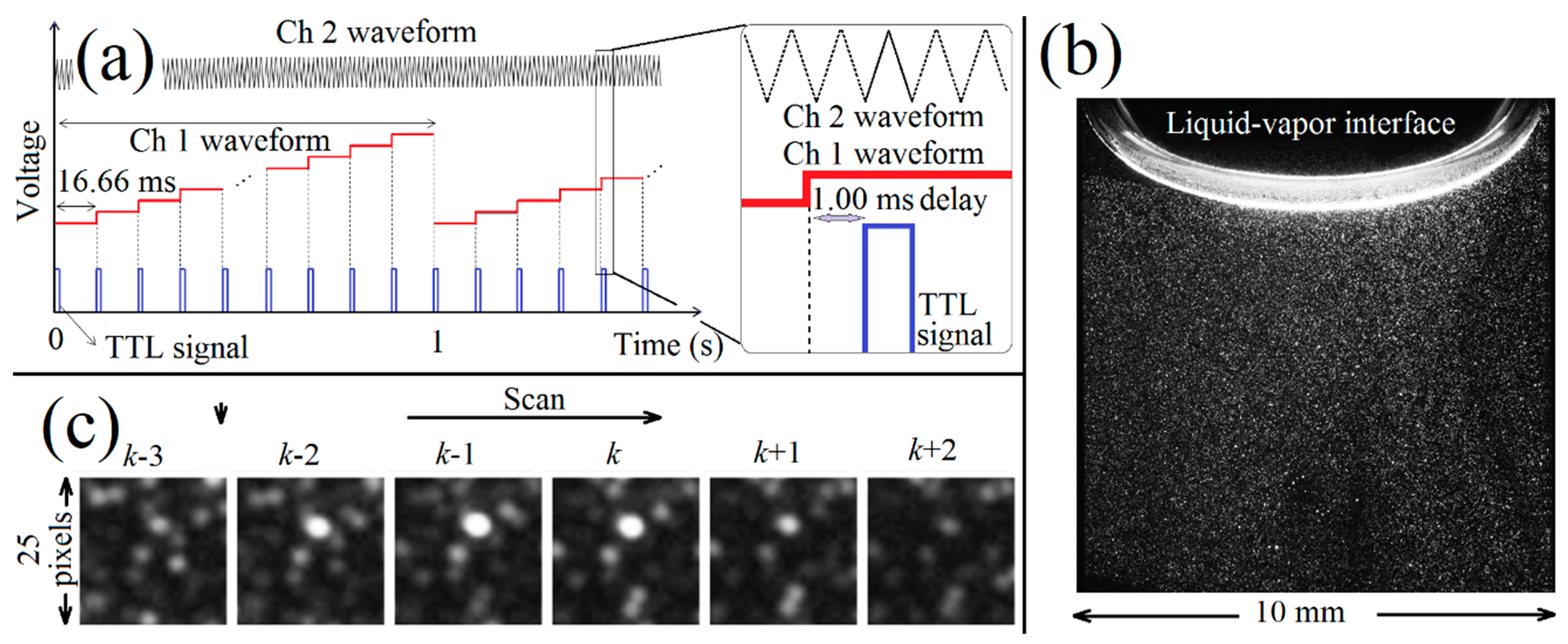
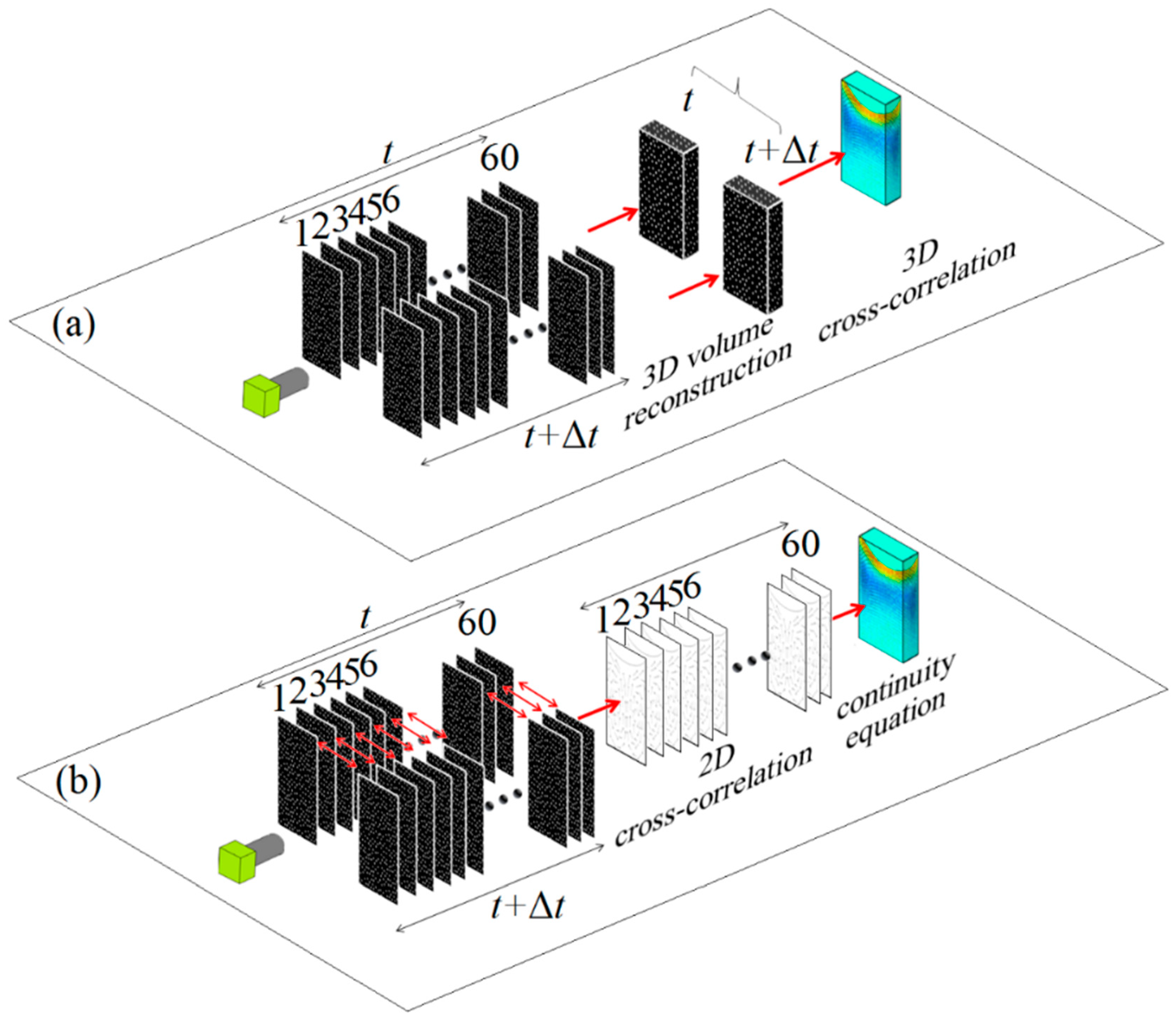
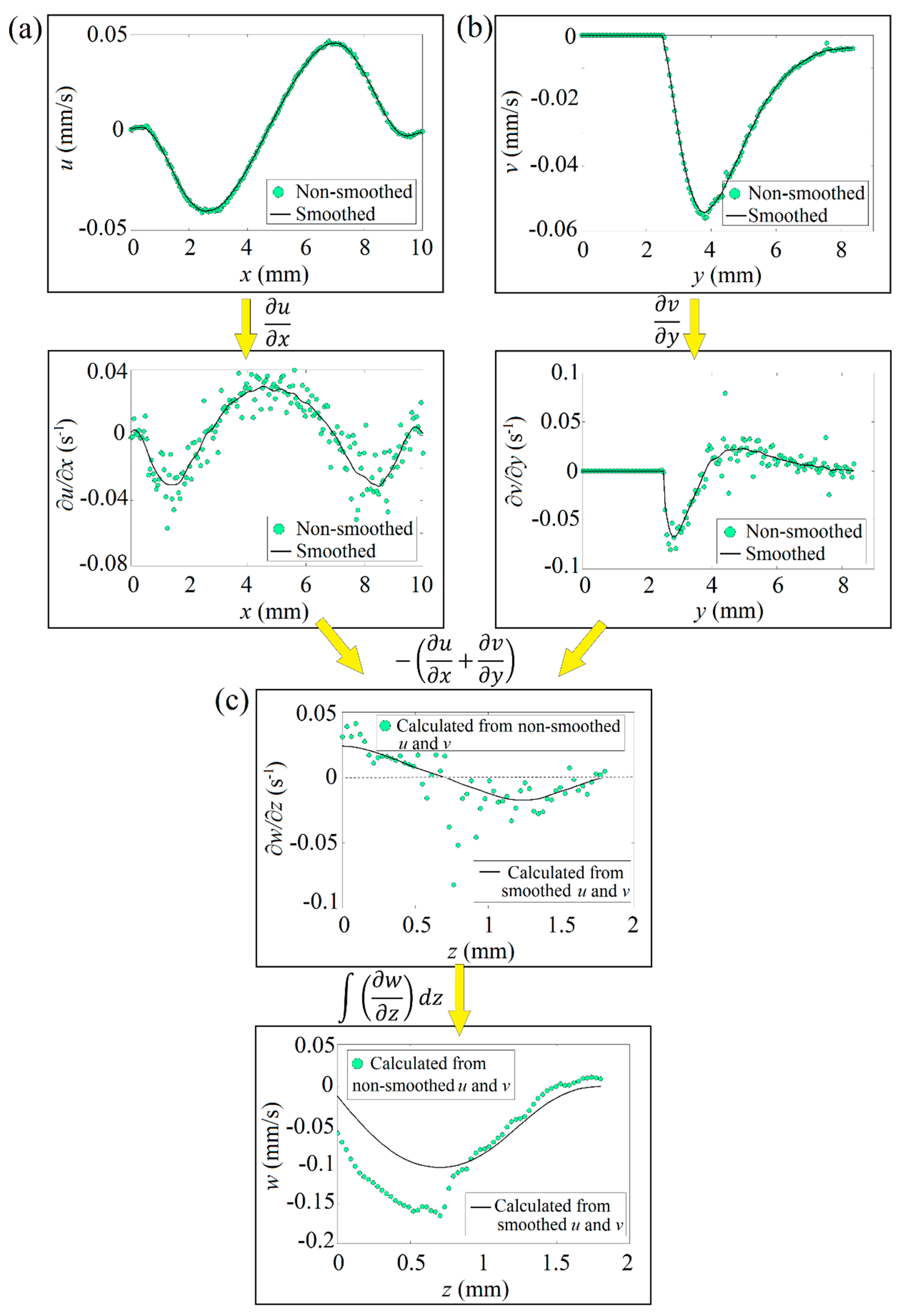
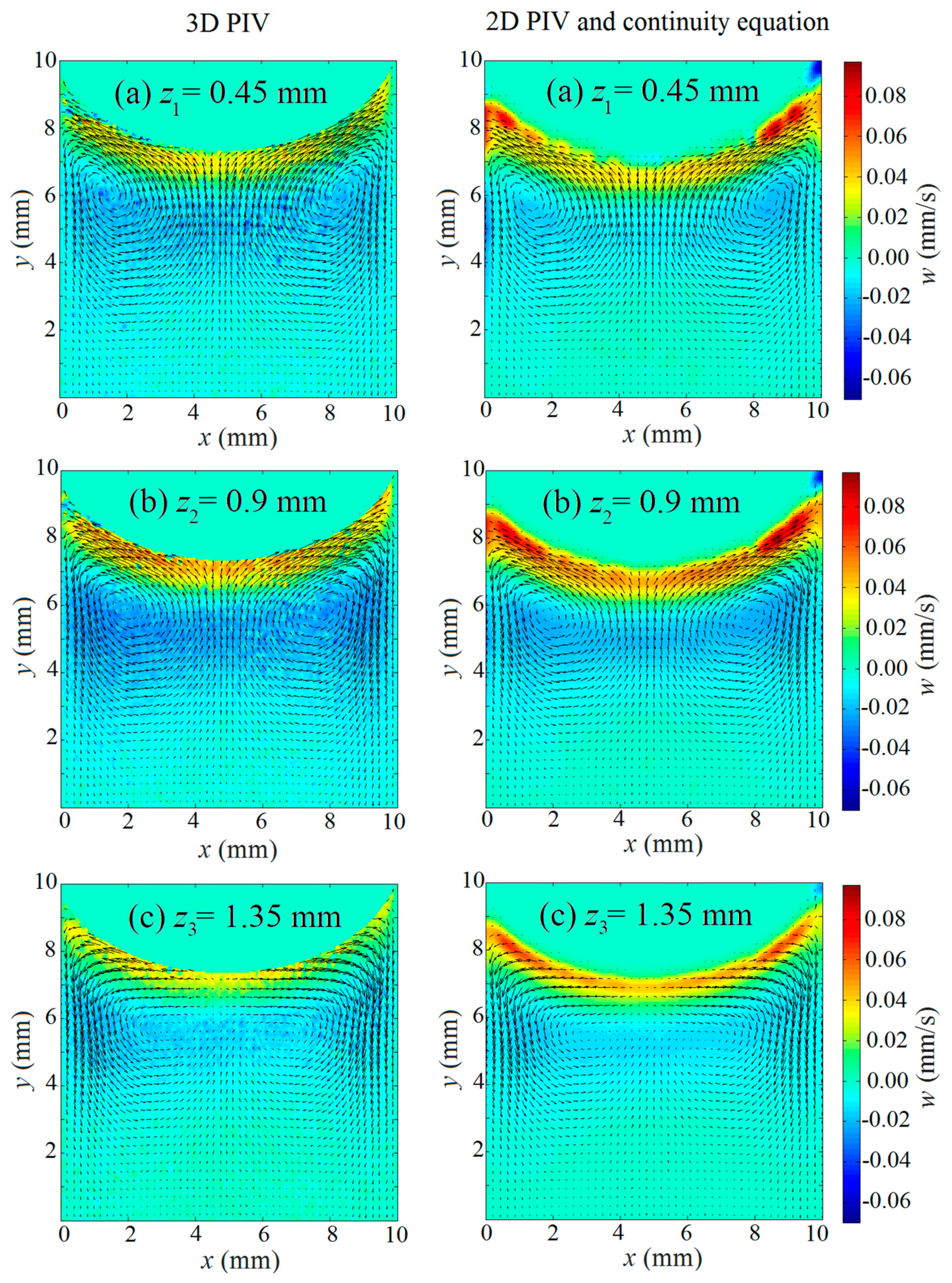

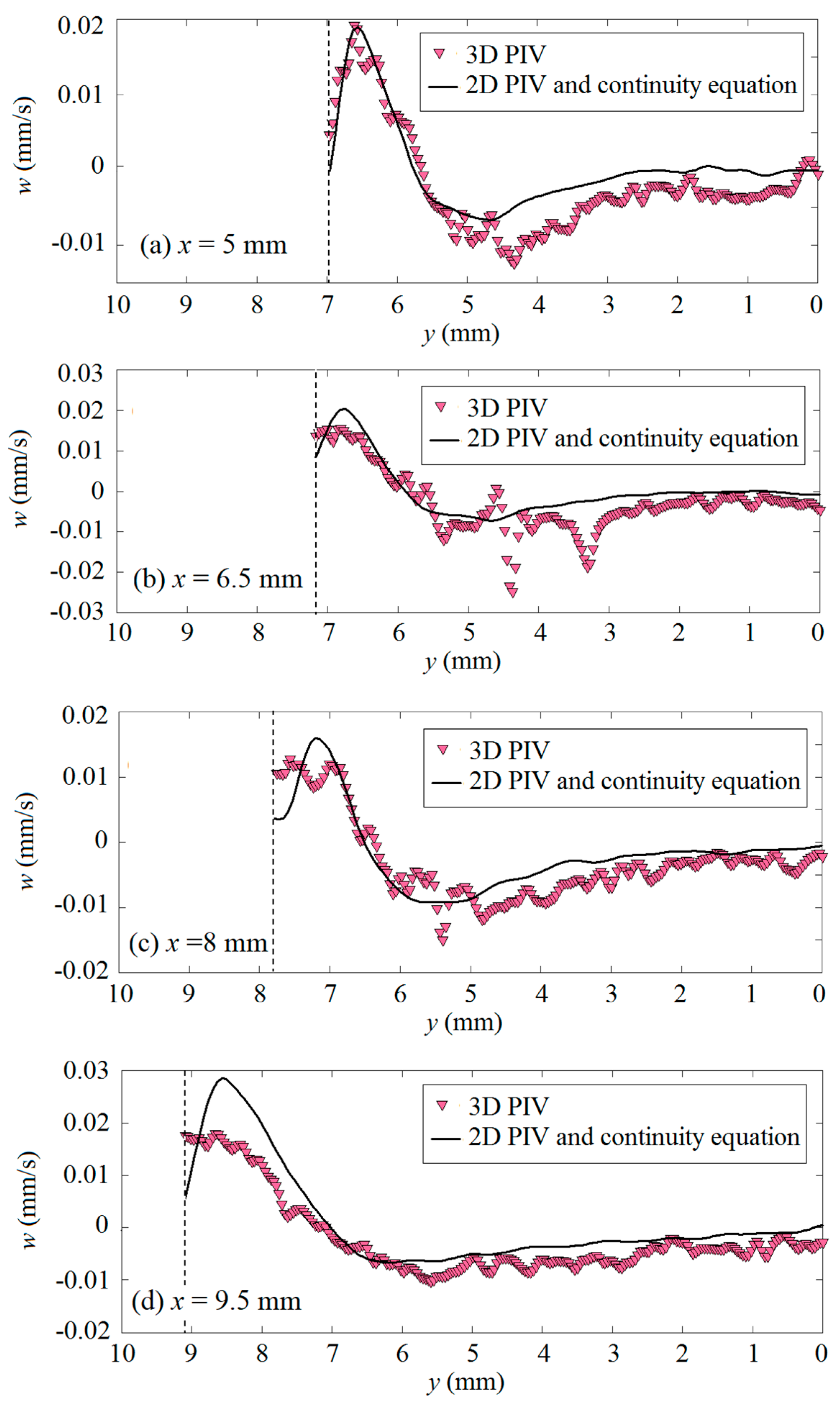
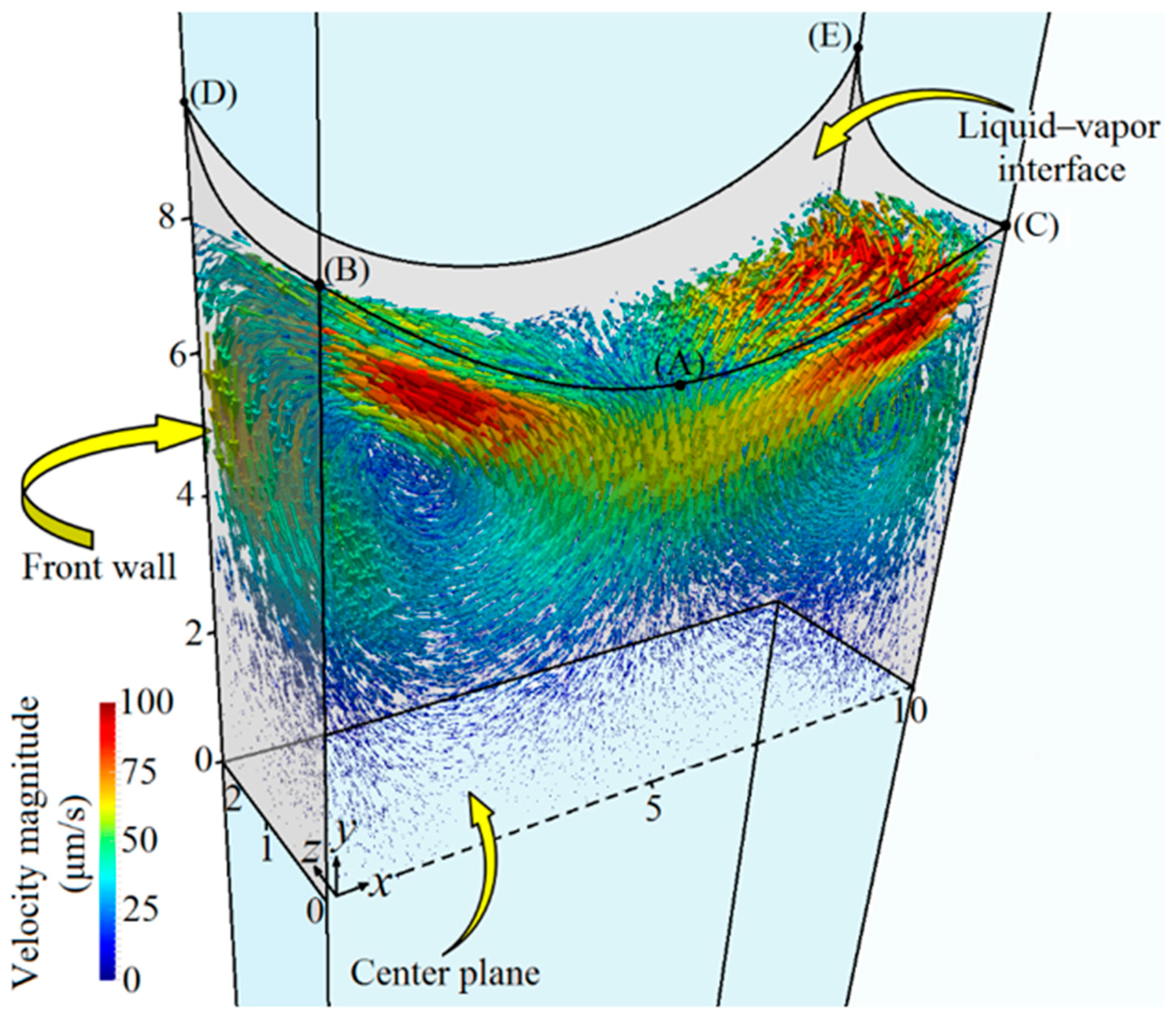
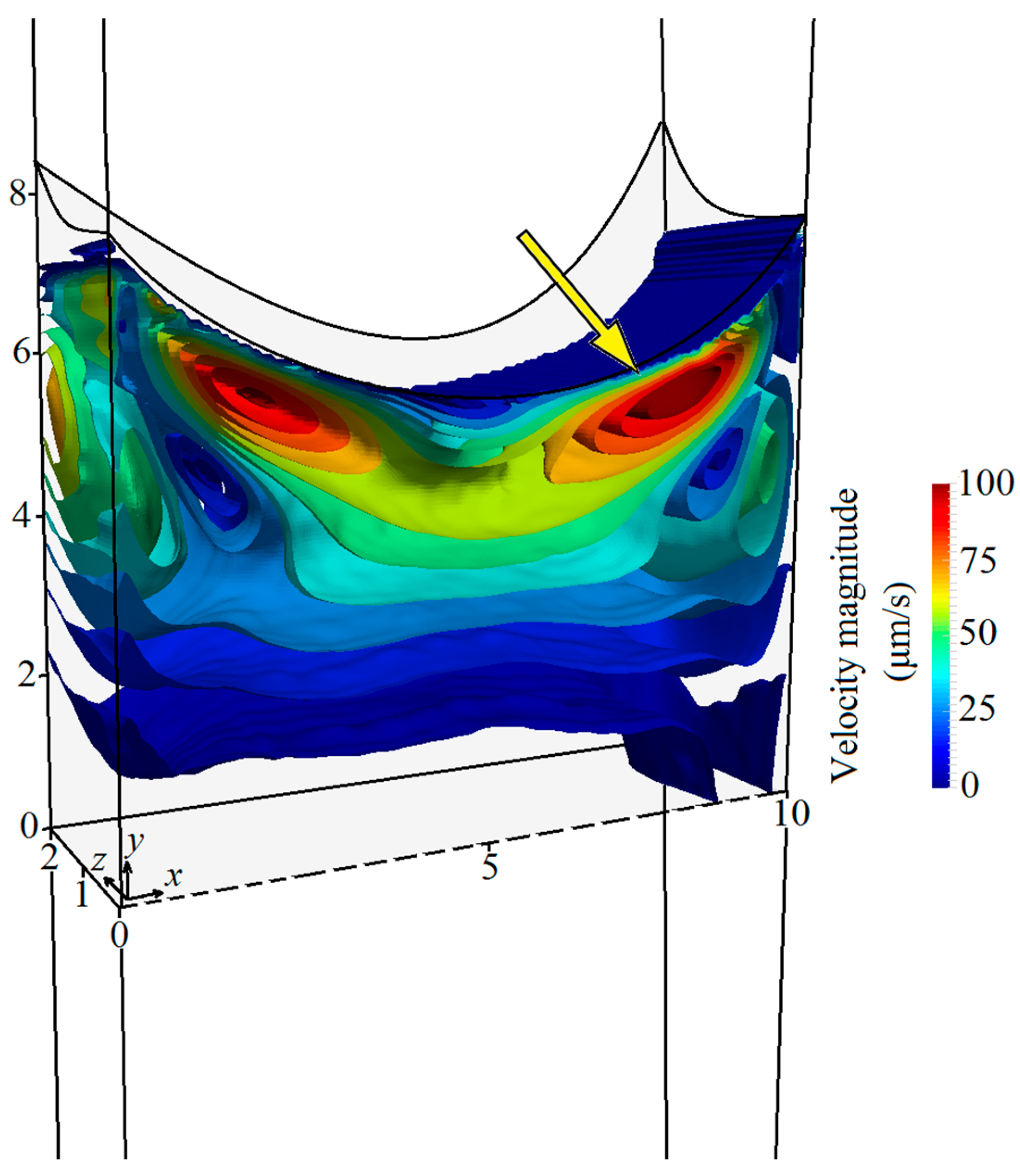
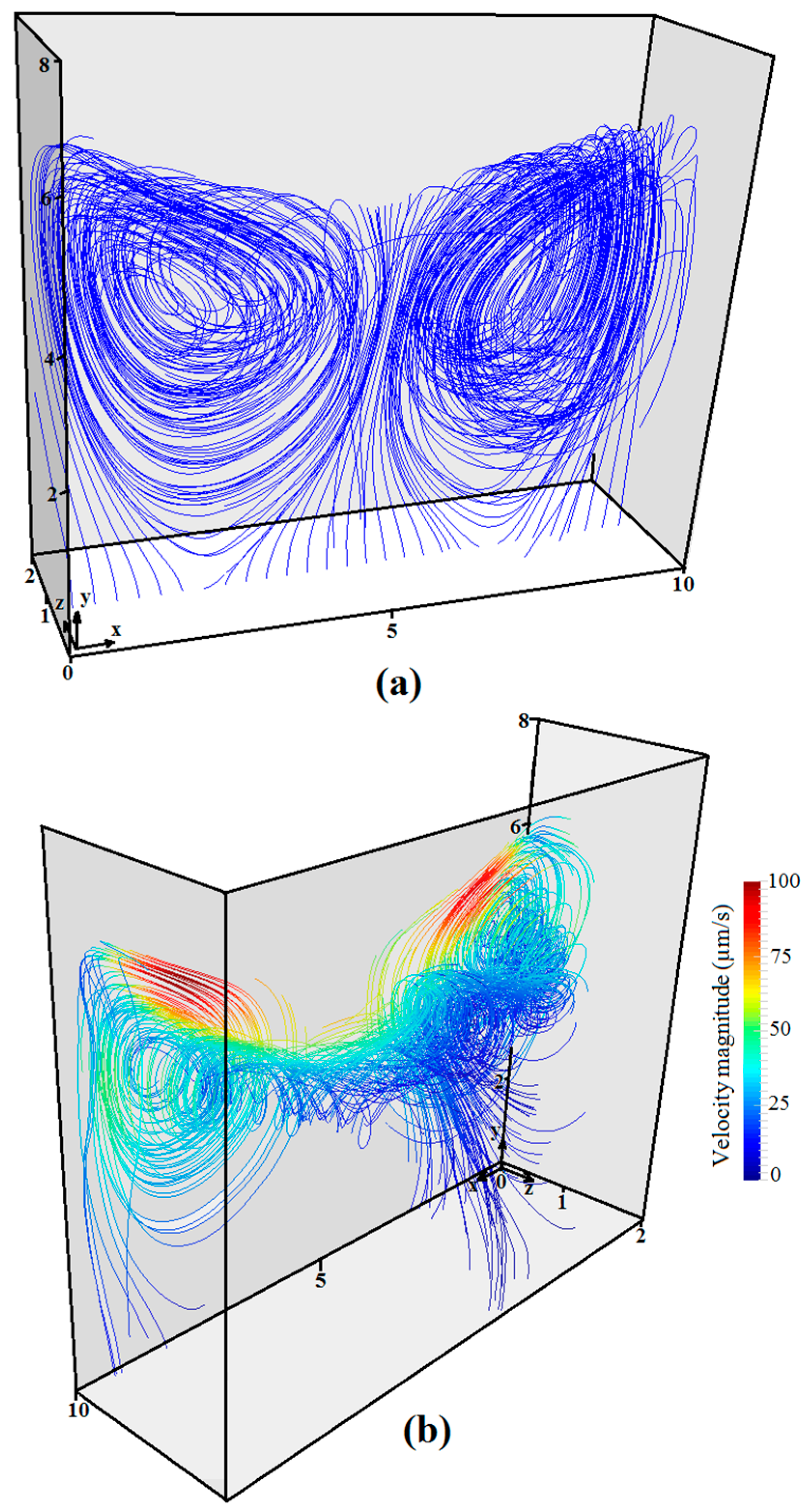
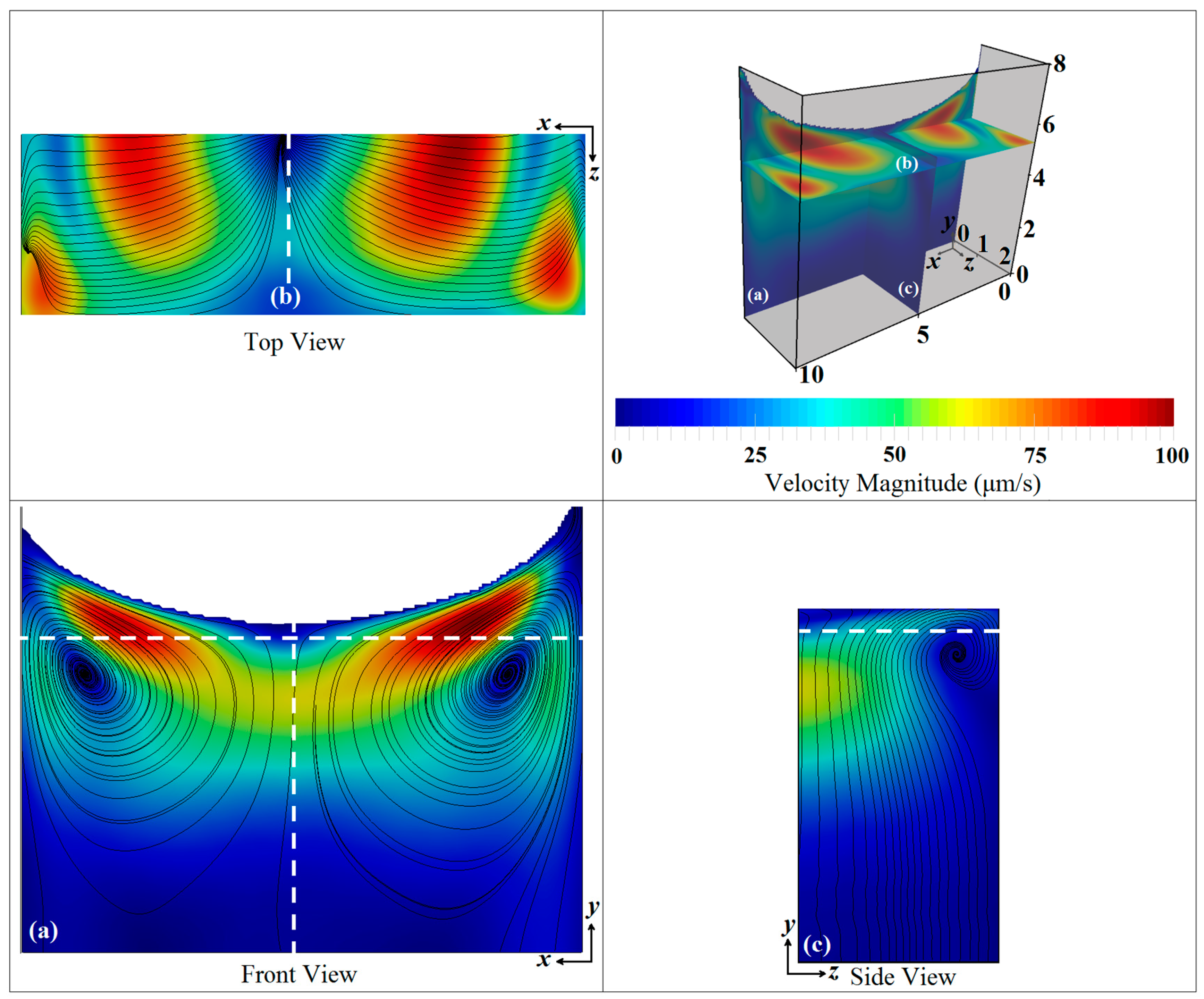
© 2020 by the authors. Licensee MDPI, Basel, Switzerland. This article is an open access article distributed under the terms and conditions of the Creative Commons Attribution (CC BY) license (http://creativecommons.org/licenses/by/4.0/).
Share and Cite
Kazemi, M.A.; Elliott, J.A.W.; Nobes, D.S. Three-Dimensional Reconstruction of Evaporation-Induced Instabilities Using Volumetric Scanning Particle Image Velocimetry. Optics 2020, 1, 52-70. https://doi.org/10.3390/opt1010005
Kazemi MA, Elliott JAW, Nobes DS. Three-Dimensional Reconstruction of Evaporation-Induced Instabilities Using Volumetric Scanning Particle Image Velocimetry. Optics. 2020; 1(1):52-70. https://doi.org/10.3390/opt1010005
Chicago/Turabian StyleKazemi, Mohammad Amin, Janet A. W. Elliott, and David S. Nobes. 2020. "Three-Dimensional Reconstruction of Evaporation-Induced Instabilities Using Volumetric Scanning Particle Image Velocimetry" Optics 1, no. 1: 52-70. https://doi.org/10.3390/opt1010005





